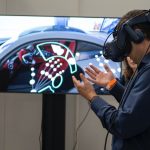Effective communication is crucial in the success of any construction project. From design to completion, clear and timely communication between all stakeholders helps ensure that everyone is on the same page, reducing the risk of errors, delays, and misunderstandings. It enables project teams to collaborate effectively, making sure that all issues are addressed promptly and … [Read more...] about Using AI and Big Data to Optimize Construction Project Communication with Clients
AR / VR
Explore the world of virtual and augmented reality. Discover the latest advancements in VR and AR technology and how they are being used in various industries. Learn how to get started with VR and AR and find resources for further learning.
From Production Line to the Driveway: How Augmented Reality is Reinventing the Car
The automotive industry has always relied on innovative technologies to improve processes and optimize the quality of production for motors. In recent years, use cases of augmented reality (AR) have been cropping up at an increasing pace, highlighting the value of the technology to the industry. The evolutionary change that AR is capable of bringing the industry can impact … [Read more...] about From Production Line to the Driveway: How Augmented Reality is Reinventing the Car
How Smartglasses Have Become Essential Tools for Healthcare Professionals
Wearable technology like smartglasses are continuing to make significant waves in the world of healthcare. From enhancing the efficiency of procedures to improving the quality of diagnoses, smart eyewear is set to bring positive change to our interactions with medical professionals. Whether we're seeking treatment for an ailment, or are looking to better understand our … [Read more...] about How Smartglasses Have Become Essential Tools for Healthcare Professionals
The Transformative Power of AR and Generative AI for Urban Landscapes
This article explores the emerging trends and applications of Augmented Reality (AR) and Generative AI, and how they're shaping the future of urban landscapes, retail, and advertising. The full article is on TheDigitalSpeaker.com. Urban landscapes are being reshaped significantly by Augmented Reality (AR) and Generative AI. This transformative technology, which was once … [Read more...] about The Transformative Power of AR and Generative AI for Urban Landscapes
Introducing the Immersive Classroom: 4 Mixed Reality Tools Teachers Should Get Their Hands On
The post-covid classroom has seen a virtual transformation like never before. As we adjust to the future of digital learning, mixed reality technologies continue to bridge the gap between remote teachers and an online classroom. From stepping inside the heart of a patient in medical school to embarking on field trips from the comfort of the school gates, AR, VR, and MR have … [Read more...] about Introducing the Immersive Classroom: 4 Mixed Reality Tools Teachers Should Get Their Hands On
What is virtual reality (VR)?
VR is a computer-generated simulation of a three-dimensional environment that can be interacted with in a seemingly real or physical way. VR is typically experienced using a headset and hand controllers, which track the user’s movements and allow them to interact with the virtual environment.
VR can be used for a variety of purposes, such as gaming, training, and entertainment. It has the potential to create immersive and interactive experiences that are not possible in the real world.
What is augmented reality (AR)?
AR is a technology that superimposes digital information or graphics onto the real world, creating a layered experience. AR can be experienced through devices such as smartphones, tablets, or specialized glasses, which use cameras and sensors to track the user’s movements and display the digital content on top of the real world.
AR is used for a variety of applications, including gaming, education, and advertising. It has the potential to enhance the real world with interactive and informative digital content.
What are the differences between VR and AR?
VR creates a fully immersive, computer-generated environment, while AR enhances the real world with digital information. VR requires specialized equipment, such as a headset and hand controllers, to experience, while AR can be accessed through everyday devices such as smartphones.
VR is typically used for fully immersive experiences, while AR is more commonly used for overlaying digital content onto the real world.
What are some examples of VR and AR?
Examples of VR include video games, educational simulations, and virtual tours. Examples of AR include Pokemon Go, Snapchat filters, and interactive museum exhibits. These are just a few examples of the many possible applications of VR and AR, which are being used in a wide range of industries and contexts.
How can I learn more about VR and AR?
There are many resources available for learning about VR and AR on Datafloq, including online courses, books, and industry events. Online courses, such as those offered by Coursera, edX, and Udacity, can provide a comprehensive overview of the technologies and their applications.
There are also many books on VR and AR that cover various aspects of the technologies and their uses. Attending industry events, such as conferences or meetups, can also be a great way to learn about VR and AR and network with others in the field. It is also possible to try out VR and AR experiences at specialized centers or through demos provided by companies that develop VR and AR technology. This can be a great way to get a firsthand experience of what these technologies are capable of.






